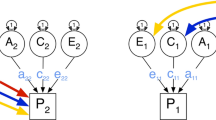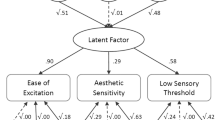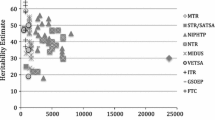Abstract
The heritability of sensation seeking is investigated in an extended twin design, including mono- and dizygotic twins and their siblings. Besides a comparison of the phenotypic resemblance between monozygotic twins and dizygotic twins, the design allows for an explicit test of the assumption that results from twins may be generalized to the singleton population. Secondly, the design offers the opportunity to investigate to what extent the influence of common environment is the same for males and females and for twins and siblings, i.e. allowing for explicit tests of a special twin environment and of a sex-specific common environment. The results indicate that individual variation in sensation seeking is heritable, with few differences between males and females in heritability estimates for the sensation seeking dimensions. In contrast to prior studies, evidence is found for common environmental influences for thrill and adventure seeking in males, and experience seeking and boredom susceptibility in females. Evidence for a special twin environment was limited to boredom susceptibility in females.

Similar content being viewed by others

Notes
SPSS-script containing the full selection procedure for our specific data set and Mx scripts for the models described in this paper are available at the Mx Scripts Library at: http://www.psy.vu.nl/mxbib
References
Arnett J. (1990). Drunk driving, sensation seeking, and egocentrism among adolescents. Pers. Individ. Dif. 11: 541–546
Aron E. N., Aron A. (1997). Sensory-processing sensitivity and its relation to introversion and emotionality. J. Pers. Soc. Psychol. 73: 345–368
Berlyne D. E., Madsen K. B. (1973). Pleasure, and reward preference: Their nature, determinants, and role in behavior. New York, Academic Press
Boomsma D. I., Vink J. M., van Beijsterveldt T. C. E. M., de Geus E. J. C., Beem A. L., Mulder E. J. C. M. et al. (2002). Netherlands twin register: A focus on longitudinal research. Twin Res. 5: 401–406
Dolan C. V., Boomsma D. I., Neale M. C. (1999). A note on the power provided by sibships of size 3 and 4 in genetic covariance modeling of a codominant QTL. Behav. Genet. 29: 163–170
Eysenck H. J. (1983). A biometrical-genetical analysis of impulsive and sensation seeking behavior. In: Zuckerman M. (eds) Biological bases of sensation seeking, impulsivity, and anxiety. Hillside, NJ, Erlbaum, pp. 1–27
Feij J. A., Dekker P. H., Koopmans J. R., Boomsma D. I. (1997). Nieuwe normen en stabiliteits gegevens voor de Spanningsbehoeftelijst (SBL). Nederlands tijdschrift voor de psychologie 52: 131–134
Feij, J. A. and Taris, T. W. (2005). Beyond the genetic basis of sensation seeking: The influences of birth order, family size and parenting styles. Submitted for publication
Feij J. A., van Zuilen R. W. (1984). Handleiding bij de spanningsbehoeftelijst (SBL). Lisse, Swets & Zeitlinger
Feij J. A., van Zuilen R. W., Gazendam A. (1982). De ontwikkeling van een Nederlandse vragenlijst voor sensation seeking: de Spanningsbehoeftelijst (SBL). Gedrag 10: 364–383
Franken R. E., Hill R., Kierstead J. (1994). Sport Interest As Predicted by the Personality Measures of Competitiveness, Mastery, Instrumentality, Expressivity, and Sensation Seeking. Pers. Individ. Dif. 17: 467–476
Fulker D. W., Eysenck S. B. G., Zuckerman M. (1980). A genetic and environmental-analysis of sensation seeking. J. Res. Pers. 14: 261–281
Goldsmith H. H., Rieserdanner L. A., Briggs S. (1991). Evaluating convergent and discriminant validity of temperament questionnaires for preschoolers, toddlers, and infants. Dev. Psychol. 27: 566–579
Gottfried A. W., Gottfried A. E., Bathurst K., Guerin D. (1994). Gifted IQ: Early developmental aspects. Plenum Publishing
Hur Y. M., Bouchard T. J. (1997). The genetic correlation between impulsivity and sensation seeking traits. Behav. Genet. 27: 455–463
Jack S. J., Ronan K. R. (1998). Sensation seeking among high- and low-risk sports participants. Pers. Individ. Dif. 25: 1063–1083
Joireman J., Anderson J., Strathman A. (2003). The aggression paradox: Understanding links among aggression, sensation seeking, and the consideration of future consequences. J. Pers. Soc. Psychol. 84: 1287–1302
Kalichman S. C., Rompa D. (1995). Sensation seeking and sexual compulsivity scales – reliability, validity, and predicting HIV risk behavior. J. Pers. Assess. 65: 586–601
Koopmans J. R., Boomsma D. I., Heath A. C., van Doornen L. J. P. (1995). A multivariate genetic-analysis of sensation seeking. Behav. Genet. 25: 349–356
Little R. J. A., Rubin D. B. (1987). Statistical analysis with missing data. New York, Wiley
Lourey E., McLachlan A. (2003). Elements of sensation seeking and their relationship with two aspects of humor appreciation – perceived funniness and overt expression. Pers. Individ. Dif. 35: 277–287
Magnus P., Berg K., Nance W. E. (1983). Predicting zygosity in norwegian twin pairs born 1915–1960. Clin. Genet. 24: 103–112
Neale, M. C., Boker, S. M., Xie, G. and Maes, H. H. (1999). Mx: Statistical modeling (5th ed.) [Computer software]. VCU Box 900126, Richmond, VA 23298: Department of Psychiatry
Pliner P., Melo N. (1997). Food neophobia in humans: Effects of manipulated arousal and individual differences in sensation seeking. Physiol. Behav. 61: 331–335
Posthuma D., Boomsma D. I. (1999). Adding non-twin siblings to increase power. Behav. Genet. 29: 366
Posthuma D., Boomsma D. I. (2000). A note on the statistical power in extended twin designs. Behav. Genet. 30: 147–158
Posthuma D., de Geus E. J. C., Neale M. C., Pol H. E. H., Baare W. E. C., Kahn R. S. et al. (2000). Multivariate genetic analysis of brain structure in an extended twin design. Behav. Genet. 30: 311–319
Potgieter J., Bisschoff F. (1990). Sensation seeking among medium-risk and low-risk sports participants. Percept. Mot. Skills 71: 1203–1206
Prescott C. A., Cross R. J., Kuhn J. W., Horn J. L., Kendler K. S. (2004). Is risk for alcoholism mediated by individual differences in drinking motivations?. Alcohol. Clin. Exp. Res. 28: 29–39
Raine A., Reynolds C., Venables P. H., Mednick S. A. (2002). Stimulation seeking and intelligence: A prospective longitudinal study. J. Pers. Soc. Psychol. 82: 663–674
Zuckerman M. (1969). Theoretical formulations. In: Zubeck J. P. (eds) Sensory deprivation: Fifteen years of research. New York, Appleton-Century, pp. 407–432
Zuckerman M. (1971). Dimensions of sensation seeking. J. Consult. Clin. Psychol. 36: 45–52
Zuckerman M. (1979). Sensation seeking: Beyond the optimal level of arousal. Hillsdal, NJ, Erlbaum
Zuckerman M. (1993). P-impulsive sensation seeking and its behavioral, psychophysiological and biochemical correlates. Neuropsychobiology 28: 30–36
Zuckerman M. (1994). Behavioral expressions and biosocial bases of sensation seeking. New York, Cambridge University Press
Zuckerman M. (2002). Genetics of sensation seeking. In: Benjamin J., Ebstein R. P., Belmake R. H. (eds) Molecular genetics and the human personality. Washington, DC, American Psychiatric Association, pp. 193–210
Author information
Authors and Affiliations
Corresponding author
Additional information
This study was supported by grants from the Netherlands Organization for Scientific research. [NWO 904-61.193 ‘Resolving cause and effect in the association between regular exercise and psychological well-being’ and NWO 575-25-006 ‘Database Twin register’].
Appendix 1
Appendix 1
The test of the assumptions of the twin design has 89 degrees freedom divided into the following nested sequence of models: First it was tested whether the age effects could be constrained to be equal across all groups and subject (23 df). Second, the means and covariances of the two DOS groups were constrained to be equal (11 df). Third, it was tested whether the means of male twins and siblings could be constrained to be equal within each sex (10 df), and whether the means of female twins and siblings could be constrained to be equal within each sex (10 df). Fourth, it was tested whether the variances of male and female twins and siblings could be constrained to be equal within each sex (2 times 9 df). This model thus estimates, for each scale, just one mean and one variance for all males, and one mean and variance for all females. Finally, the covariances of corresponding pairs were constrained to be equal (17 df). That is, this model constrains the same sex male twin-sibling covariances to be equal, as well as the same sex female twin-sibling covariances, and the opposite sex twin-sibling covariances.
Rights and permissions
About this article
Cite this article
Stoel, R., De Geus, E. & Boomsma, D. Genetic Analysis of Sensation Seeking with an Extended Twin Design. Behav Genet 36, 229–237 (2006). https://doi.org/10.1007/s10519-005-9028-5
Received:
Accepted:
Published:
Issue Date:
DOI: https://doi.org/10.1007/s10519-005-9028-5



